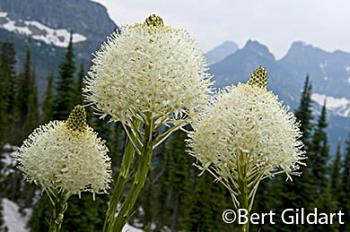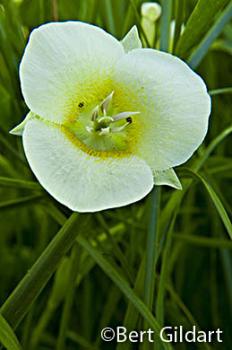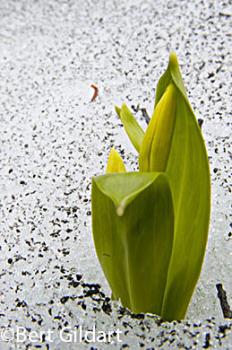Lilies In Glacier National Park
©Bert Gildart: Hundreds of different species of wildflowers rear their heads in Glacier National Park throughout the brief summer, and though many appear to be drastically different from one another, some seemingly improbable species are in the same family and so share certain taxonomic characteristics.

Bear Grass
Three flowers now rearing their heads are all members of the lily family, meaning that they have a similar floral formula. For lilies, all must have three sepals, three petals, six pistils, and three stamens–else they’re not lilies. Pistils are the female reproductive portion of the flower and stamens, the male.
Flowers belonging to other family groups have different formulas, and roses are a good example for some of them are also blooming. Members of this family have the formula 5,5,15,5.
Though there are more than three lilies now blooming in the park, three I discovered the other day include purple-eyed mariposa, glacier lily and the bear grass.
BEARS EAT IT–BUT SELECTIVELY
Because of its size bear grass may fool you, but if you take a quick look at one of the hundreds of individual flowers comprising the plant’s head, you’ll see, in fact, that it does conform to the 3,3,6,3 family formula. Though not as dense as I’ve seen it in some years along the park’s Highline Trail, still you’ll see many clusters.

Purple-eyed mariposa
The species is cyclic and once about every eight years bear grass seems to run from one valley edge to the other. And despite its name, bears eat only the tender, juicy base of the grasslike leaves, and generally do so only upon emerging from hibernation. Then they turn to other sources of food, such as the bulbs of glacier lilies.
Purple-eyed mariposa lily can often be confused with the sego lily which also flourishes in the park. The two look almost exactly alike but mariposa can be differentiated from the sego by the small black dot at the base of each one of the petals. Because of the orientation of the petals, in the image here, you can see only two of those dots.
Years ago when I first began working in Glacier as a seasonal ranger, I purchased a book by the well-known Craigheads on wildflowers and use it to this day. In the book it says that the very similar sego lily was once used by Mormons during lean years.
It also says that you can eat the bulbs produced by other members of the genus Calochortus, and that means purple-eyed mariposa.
MOST CONSPICUOUS LILY
The most conspicuous lily now blooming is the glacier lily. It is a conspicuous showy plant as its scientific name suggests. Erythronium is taken from the Greek word “erythro” meaning red, and sometimes its petals do have a reddish tinge. Its specific name, grandiflorum, means large-flowered, easy to appreciate when it is in full bloom.
The flower in the image shown here is just starting to appear, but if you look at my July 24th posting , you’ll see fully developed petals fluttering in all their vivid glory.
Once, glacier lilies were a food source for some Native American tribes. Bulbs were boiled or dried to eat during the winter months. Various species of wildlife also eat them and when they emerge, grizzly bears often seek them out.
Grouping members of plants together in families is a good way to learn more about the uniqueness of plants, and perhaps this will serve as a start. Literally hundreds of species are now blooming, but as with so many things in Glacier, you can’t wait too long, else they’re gone, not to reappear for another year.

Glacier lily
UPDATES: Many expressed an interest in the huge pike caught by Gene Colling in my Holy S—- posting. Gene’s traveling companion Bill Schneider, who writes for the online magazine, New West, just posted a story about their adventure and included Gene’s Video, just released. If you’re a fisherman, you won’t want to miss it.
PREVIOUS POST, THIS ONE FROM JULY, 2006–a story about our nation’s second national park, which existed but briefly:

